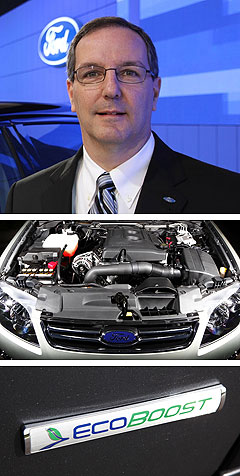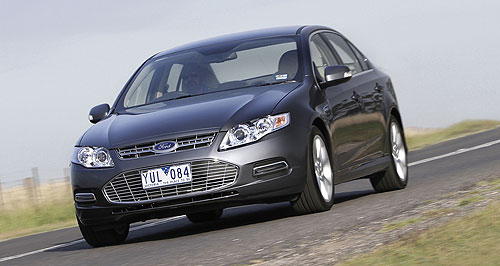News - Ford - Falcon - EcoBoostFord Australia keeps faith in Falcon fourConfidence boost: Ford CEO predicts sales of the Falcon EcoBoost to increase. Proportional sales remain low, but Ford Oz says give Falcon four-cylinder more time16 Apr 2013 FORD Australia president and CEO Bob Graziano has defended the continued low uptake of EcoBoost four-cylinder versions of the Falcon large car, almost a year on from launch. The Blue Oval released its first four-pot Falcon – powered by a potent 179kW/353Nm 2.0-litre turbocharged direct-injection petrol engine – in April 2012, addressing concerns over the Australian-made sedan’s fuel consumption compared to popular small cars and increasingly frugal compact SUVs. While the company predicted small volumes at first as it sought to show buyers that the downsized engine would have sufficient poke, it was thought the more frugal offering could eventually win back customers and help arrest the car’s continued sales decline. In the ensuing period, Falcon sedan sales have continued to fall and deliveries were down 34.8 per cent last month (831 units) compared to March 2012 – before the introduction of EcoBoost. Ford is not alone here, with the large-car segment as a whole down 32.9 per cent in March as Holden also struggles with the Commodore. While official VFACTS industry figures do not break down the proportion of Falcon sales by powertrain, combined sales of the EcoBoost petrol and six-cylinder EcoLPI gas versions were believed to account for around 16 per cent. This means that the vast majority of all Falcon sales continue to use the Geelong-built inline-six engine, leaving only a trickle of imported EcoBoost fours. As GoAuto reported exclusively last week, General Motors is currently testing a four-cylinder engine on the Commodore’s ‘Zeta’ platform, but has indicated that it is “not in the near future” for Holden’s Australian-built large car, due largely to the slow sales of the four-cylinder Falcon. GM’s global executive chief engineer for luxury and rear-wheel-drive cars, David Leone, told GoAuto in New York that he had “tracked the data and the four-cylinder Falcon from a sales standpoint is insignificant – it doesn’t look like it helped them”. “Perception lags reality in this business and it (four-cylinder Falcon) is quite a good car but it doesn’t appear to be getting the customer,” he said.  Left: Ford Australia president and CEO Bob Graziano. Left: Ford Australia president and CEO Bob Graziano.Ford Australia remains confident the tide will turn for EcoBoost, with Mr Graziano this week citing the difficult road the company had already travelled when it replaced a V8 with a six-cylinder EcoBoost engine in its iconic F-Series truck in the US. “When we launched the EcoBoost Falcon, I think we were pretty clear that we thought it was going to take people a while to overcome their perception of a four-cylinder’s ability to work in a large car,” he said. “It was not to dissimilar to the challenge we had with EcoBoost in F Series in the US, and the last data that I saw said that over 40 per cent of F-Series sales now are EcoBoost powertrains. “They went from nothing to 40 per cent, which I think is a significant percentage, but it took years to get there, for that same perception. “I don’t know if Falcon will get to 40 or 50 per cent, but what we need to do is to keep getting people into that vehicle, and have them understand how good that EcoBoost powertrain is in the Falcon. “I didn’t really have projection on where I thought it would be at this point, we are looking at it to increase month on month, year on year, that’s what we’ve got to continue to push. “So we’re not seeing huge uptakes in EcoBoost but as you get more awareness and word of mouth out there, then I think you’ll start getting a bit more momentum behind it.” On the subject of Falcon sales momentum, Ford has confirmed the long-awaited Falcon ‘freshening’ or facelift will hit the market in the second half of 2014, around the same time as the cosmetically upgraded (and also Australian-made) Territory SUV appears. The $103 million project – a co-investment between Ford and federal and state governments – will bring improved fuel economy thanks to engine tweaks, a revised six-speed automatic transmission and aerodynamic tweaks, as well as more cabin technology and facelifted styling. Mr Graziano would not say directly if the upgrade was the booster shot the car needed, but did indicate the Blue Oval would continue to support the vehicle. The company has previously said the facelifted Falcon will last until 2016, but has not commented on local manufacturing beyond then. “We’re continuing to talk about what we think are the benefits of the vehicles,” he said. “(But) you’ve seen what’s happening in that segment, it’s a tough segment, and it’s been a tough segment for over a decade.” While Holden last week announced a further 500 Australia job cuts partially due to slow Cruze and Commodore sales, Ford Australia says it has no immediate plans to announce any employee reduction of its own. Ford Australia shed 440 jobs from local operations last July, although later found work for more than 100 of these staff in product development and at its newly in-house Ford Performance Vehicles operations.  Read more9th of April 2013  GM Zeta prototype gets four-pot Opel OPC powerGeneral Motors is testing a four-cylinder turbo powertrain on Commodore platform22nd of October 2012  Shock and awe for Ford’s 2014 FalconFord Australia design chief promises ‘big impact’ with reskinned 2014 Falcon |
Click to shareFord articlesMotor industry news |
















Facebook Twitter Instagram